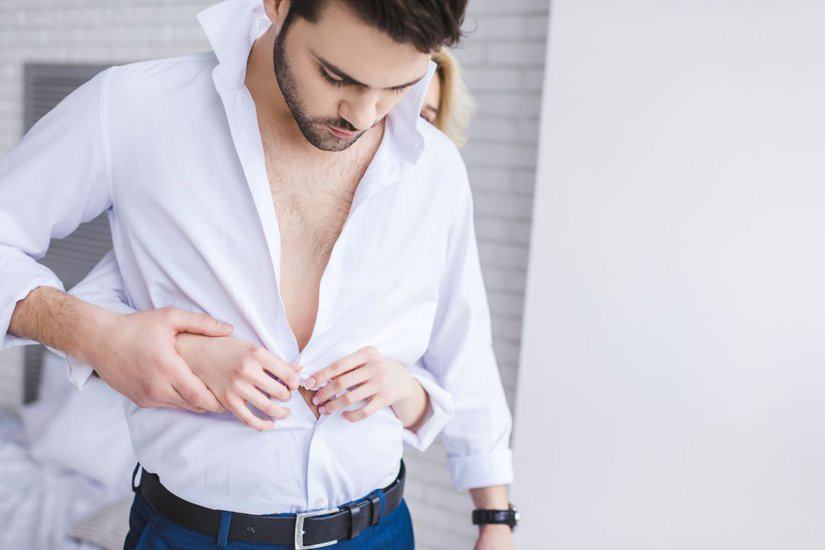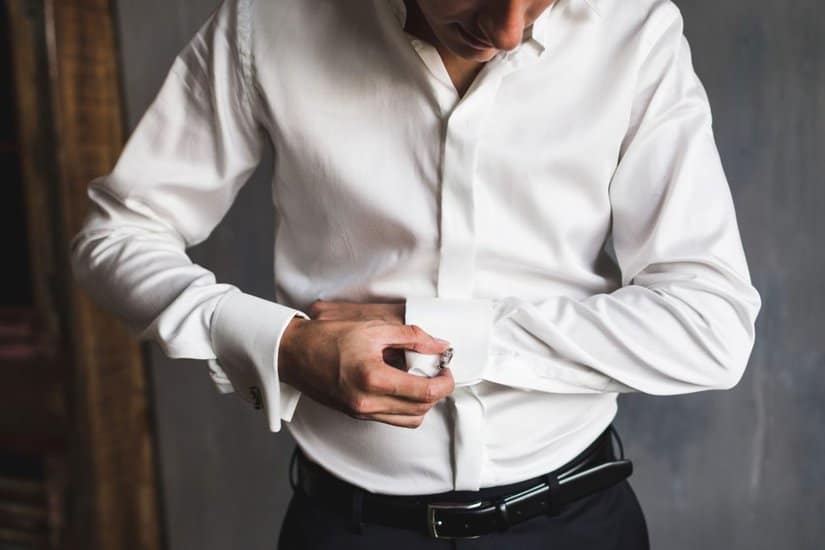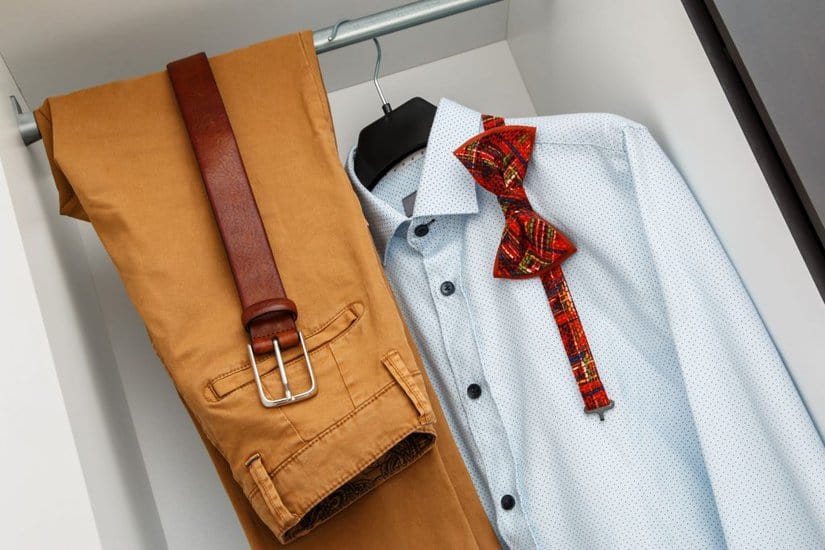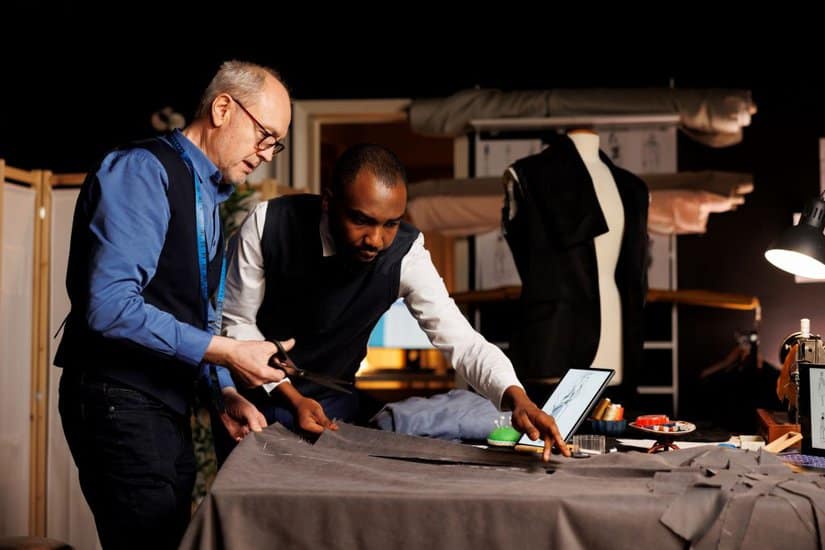Determining whether to tuck in a shirt can often pivot on the type of shirt involved and the dress code of the environment. Classic dress shirts with a longer hem are traditionally worn tucked in to present a polished and professional silhouette.
These shirts are designed with extra length to ensure they stay in place throughout the day. Conversely, shirts with an even hem, like many casual styles, provide the flexibility to be worn untucked for a more relaxed appearance.

The act of tucking in a shirt also communicates an awareness of formality and context. In professional or formal settings, a neatly tucked shirt can convey a sense of preparedness and respect for the occasion.
In casual environments, the choice to leave a shirt untucked may come down to the shirt’s design, your personal style, or the desired level of comfort. For every shirt and situation, there are methods and tips to consider which not only improve the look but also the wearer’s confidence.
Key Takeaways on Which Shirts Should Be Tucked In?
- A tucked in shirt typically indicates formality and professionalism.
- Casual shirts can be worn untucked for comfort and ease.
- The choice of tucking is influenced by the shirt design and occasion.
Also don’t miss:
- Is an Untucked Shirt Formal?
- Is It Ok to Wear a Blazer With an Untucked Shirt?
- How Do You Button a Dress Shirt?
The Basics of Shirt Tucking
When deciding whether to tuck in or leave a shirt untucked, several factors come into play, such as hem design, shirt style, fit, shirt length, and proportions of the body and clothes. I’ll guide you through the essentials of shirt tucking.
- Tucked Shirts: Shirts with a longer hem in the back and front, often with a more tailored fit, are intended to be tucked in. Tucking in these shirts helps maintain a clean, professional look and is essential for formal or business attire.
- Example: Dress shirts with an uneven hem are a clear candidate for tucking.
- Untucked Shirts: Casual shirts, like t-shirts or those with an even hem that falls just below the belt line, are designed for an untucked style.
- Example: A flat bottom hemmed Hawaiian shirt is perfect to wear untucked.
| Style | Description |
| Formal | Shirts with uneven hems and typically stiffer collars should be tucked in for a polished appearance. |
| Casual | Shirts with an even hem, such as t-shirts or polos, can be left untucked for a relaxed look. |
For those wavering on how to tuck in a shirt properly, here’s a quick guide:
- Start by buttoning up your shirt.
- Tuck the hem neatly into your trousers all around.
- Ensure the shirt is smooth and not bunched up.
- Adjust your belt if necessary for a neat finish.
In terms of proportions, a shirt should not bulge or billow excessively; it should align closely with the contours of your trousers to maintain a clean silhouette. Remember, the goal of shirt tucking is to enhance your overall style and ensure that your outfit is proportionate and fits well.
Different Shirt Types and Tucking Rules
When dressing for any occasion, understanding the proper etiquette for tucking in different types of shirts is essential. I’ll clarify which shirts should be tucked in and which can be left untucked, according to their design and the context in which they are worn.
Dress Shirts
Dress Shirts: These are typically worn in formal settings and are best kept tucked in to maintain a polished look. Dress shirts often have a longer hem and “tails” that signify they are meant to be worn inside the trousers. Not tucking these in can appear disheveled.
- Example: A classic white dress shirt is designed with tails and should always be tucked in.
Casual and Informal Shirts
Casual and Informal Shirts: This category includes a variety of shirts, and the rules can vary:
- T-Shirts: Often left untucked for a casual look, unless layering under another item like a jacket, where a tuck might be necessary for a cleaner silhouette.
- Polo Shirts: Can be tucked or untucked; however, tucking can lend a sharper appearance, especially when worn with dressier pants or during professional casual events.
- Henley Shirts: Tucking in is optional and leans on personal preference or the setting—untucked for a laid-back vibe or tucked for a neater ensemble.
- Hawaiian Shirts: Typically worn untucked due to their casual nature and often straight hem.
- Flannel Shirts: These can be worn untucked for relaxed settings, but if the flannel is serving as an overshirt or if the event is more formal, tucking might be required.
Specialty Shirts
Specialty Shirts: Include various designs each with different tucking considerations:
- Tank Tops and Undershirts: Usually not tucked unless worn as an undershirt for additional layering.
- Guayaberas: These are traditional shirts often worn untucked due to their hemline and side vents.
- Rugby Shirts: Similar to polo shirts, they can be tucked or untucked based on the formality of the occasion and personal style preferences.
- **Henleys, again, can vary in style; some warrant a tucked-in look while others should be left untucked depending on the setting and overall outfit.
Tucking Techniques and Tips

When it comes to maintaining a neat appearance with button-down shirts, various tucking methods can be employed to achieve a polished look. My approach to tucking centers on showcasing a crisp and orderly silhouette.
1. Military Tuck
In the military tuck, I focus on eliminating billowing and ensuring a flatter front. I start by tucking in the shirt normally, then pinch and fold back the excess fabric along the seams at my sides. This method provides a clean back and sides, particularly when I need a trim, uniform appearance.
2. Full Tuck
A full tuck involves tucking the shirt fully into the trousers around the entire waistline. I make sure my shirttails are tucked in evenly, and I often employ shirt stays to keep the shirt smoothly in place throughout the day. This is essential for formal settings where I can’t compromise on neatness.
3. Front Tuck
The front tuck, or French tuck, allows for a more casual, yet intentional look. I simply tuck in a small portion of my shirt into the front of my trousers and leave the back untucked. This style works well for creating a subtle distinction in casual outfits.
4. Half Tuck
Lastly, the half tuck combines the laissez-faire attitude of the front tuck with a touch more structure. I tuck in one side of my shirt – the side with the button placket – while the other remains untucked. It’s an effortlessly stylish choice for a relaxed, yet considered appearance.
Accessorizing with Tucked Shirts

When I tuck my shirt, I pay close attention to how I accessorize. The right belt, buckle, or layering piece like a tie or sweater can enhance the tucked shirt’s appearance significantly.
Belts and Buckles
When selecting a belt for a tucked-in shirt, ensuring a good fit and complementary style is crucial. For dressy occasions, a sleek leather belt with a polished buckle adds a touch of class, whereas for casual settings, a wider belt with a more distinctive buckle can express personal style. Often, the buckle itself acts as a focal point, so I choose one that’s in harmony with the rest of my outfit.
Ties and Sweaters
The addition of a tie can elevate a tucked shirt from casual to formal. A tie should complement the shirt without overwhelming it—the pattern and color should match the shirt and suit if I’m wearing one. On colder days, layering a sweater over a tucked-in shirt not only keeps me warm but also offers a more sophisticated look. When wearing a sweater, I ensure it fits well; too loose, and it can look sloppy, too tight, and it’s uncomfortable.
Understanding the Role of Fit and Tailoring

When it comes to deciding whether to tuck in a shirt, fit plays a pivotal role. I always check the shirt’s fit, especially around the shoulders and sleeves, to ensure they align properly with my body’s contours.
This alignment is crucial for a polished look when a shirt is tucked in. For more formal occasions, a well-tailored shirt that complements my silhouette is likely to stay neatly tucked, providing a clean, proportionate appearance.
It’s essential to consider the button placement and shirt length; a shirt designed with longer tails tends to remain tucked in throughout the day. For casual styles, the fit should still be snug but comfortable, allowing for movement without sacrificing form. Here’s what I keep in mind:
- Shoulder and Sleeve Fit: The seam should sit at the top of the shoulder, and sleeves should not extend beyond the base of the thumb.
- Collar Fit: The collar should sit comfortably when buttoned, without constricting my neck.
- Shirt Tails: Long tails are indicative of a shirt meant to be tucked in.
When I opt for a tailored shirt, it means more than simply choosing the right size. I focus on the way the garment drapes and contours my body. This attention to fit reduces the likelihood of the shirt billowing or pulling out of my pants.
Ultimately, a shirt that fits well and is correctly tailored enhances my overall appearance and ensures my look is appropriate, whether it’s for a formal event or a smart casual setting.
Navigating Different Occasions
When I attend different events, I always consider the dress code to ensure my shirt tucking aligns with the occasion. My approach varies from formal to casual settings, keeping in mind whether the event calls for a crisp professional look or a relaxed off-duty vibe.
1. Formal Occasions
For black-tie events or weddings, I ensure my dress shirt is impeccably tucked in, often accompanied by a cummerbund or waistcoat. The gig line—the line formed by the edge of my shirt, belt buckle, and trouser fly—must be perfectly aligned. The silhouette should be smooth, with no billowing fabric at the waistline.
2. Professional Settings
In a professional environment like an office or a business meeting, I maintain a professional look by tucking in my dress shirt. I make sure it stays put throughout the day, often using shirt stays. A properly tucked shirt in these settings conveys a sense of formality and preparedness.
3. Casual Outings
When I’m out socially or simply enjoying the day, untucked shirts can offer a more casual look. However, the shirt should fit well and not be too long or wide; it should fall just about halfway down the trouser fly. Since the pandemic, there’s been a more relaxed attitude towards casual dress codes, but I still aim for an intentional, put-together look.
4. Maintaining a Professional Look
Even for less formal professional settings, such as a creative workplace or a casual Friday, I maintain a balanced approach. If I choose an untucked shirt, I make sure it looks intentional and not sloppy. It’s still important that the shirt complements the overall outfit and does not distract with an untidy appearance.
5. Contemporary Shirt Tucking Trends
Fashion trends evolve, and so do the norms for tucking in shirts. To stay updated, I keep an eye on current styles. I’ve noticed a trend where some prefer to tuck in just the front of the shirt, known as the French tuck, which can offer a casually tailored look appropriate for certain “off-duty” yet stylish situations.
Frequently Asked Questions
When it comes to tucking in shirts, there are specific guidelines that can help you achieve the right look for any occasion, whether you’re aiming for a polished, professional, or casual style.
What are the guidelines for tucking shirts into jeans for a polished look?
For a polished look with jeans, I recommend tucking in shirts that have a more structured fit and adding a belt. Shirts with a dressier fabric or a detailed button placket are ideal for tucking into jeans to create a clean and refined appearance.
How does one decide when to tuck in a shirt for a professional female attire?
When dressing professionally, women should tuck in their shirts to present a more formal and tailored look. This typically includes blouses that pair with suits or pencil skirts. A shirt with a straight hem can be partially tucked for a semi-formal appeal.
What types of shirts are designed to be worn untucked?
Shirts designed to be worn untucked usually have a flat bottom hem. Casual shirts, such as camp collars and some oxford styles, are often cut shorter and straight across, making them suitable to be worn untucked.
Is it fashionable for men to tuck T-shirts into pants?
Tucking T-shirts into pants is not conventionally fashionable for men; it’s usually best to leave T-shirts untucked unless creating a very specific retro or stylized look.
How does the shirt’s hemline affect the decision to tuck or not tuck?
The hemline of a shirt greatly influences the decision to tuck. Shirts with an even, short hem are often designed to stay untucked, while shirts with long tails or an uneven hem should be tucked in for a neat appearance.
Are there specific shirt styles for women that are meant to be tucked into skirts or trousers?
Yes, women’s shirts with tailored cuts, stiff collars, and longer hems are designed to be neatly tucked into skirts or trousers, creating a streamlined silhouette. Blouses with details such as ruffles or ties also work well when tucked in to accentuate the waistline.

Samoel Ovanessian is the founder and creator of StylishAlpha.com – a website dedicated to men’s fashion. As a proud owner of more than 200 ties, he loves digging through new clothing combinations for everyday use, formal events and even just for fun. You can read more about Samoel here.

